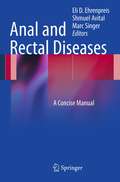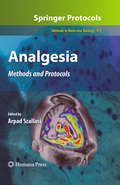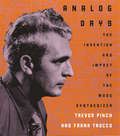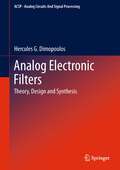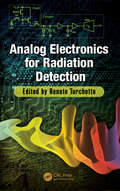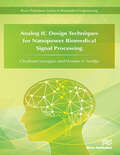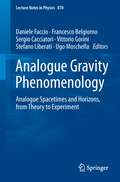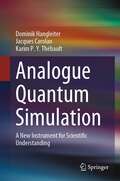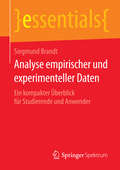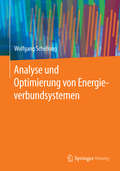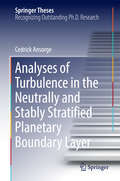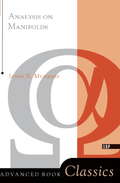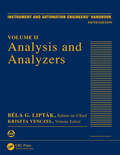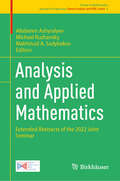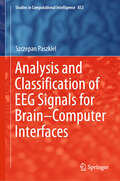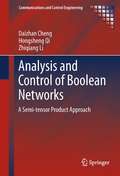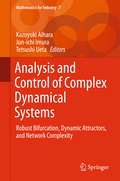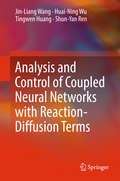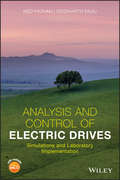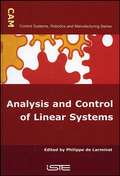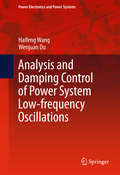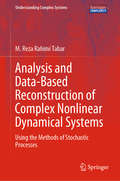- Table View
- List View
Anal and Rectal Diseases: A Concise Manual (Remedica Explained S. Ser.)
by Mark Singer Eli D. Ehrenpreis Shmuel AvitalAnal and Rectal Diseases: A Concise Manual provides a succinct reference on the subject for clinicians, including primary care physicians, gastroenterologists, general surgeons, physician's assistants and nurse practitioners. Presented in a consistent structural style that provides both a general summary of individual topics within the field along with additional details to assist those with some background knowledge in the subject area, this handy volume provides information related to the field of anorectal disease in a format that is easily accessible for rapid acquisition of knowledge. Each topic is outlined in a multidisciplinary fashion with the medical, surgical, and pathological aspects clearly detailed in each section. Each section clearly describes the condition with up-to-date management guidelines and precious clinical pearls. The volume features high quality illustrations in the form of elegant hand drawn figures, tables, photographs of physical findings, endoscopic finds and radiographs. The clinical photographs and x-rays will be of great value to gastroenterologists whose specialty is not coloproctology. Chapters on computerized tomographic colography (virtual colonoscopy) and others cover the newer technologies employed for diagnostic purposes in these diseases. Anal and Rectal Diseases: A Concise Manual provides clinicians with a tool for rapid consultation for direct patient care and management.
Analgesia: Methods and Protocols (Methods in Molecular Biology #617)
by Arpad SzallasiChronic pain is a complex phenomenon, which continues to remain undertreated in the majority of affected patients thus representing a significant unmet medical need, but the development of cellular, subcellular, and molecular methods of approaching this epidemic of pain shows great promise. In Analgesia: Methods and Protocols, experts in the field present thorough coverage of molecular analgesia research methods from target discovery through target validation and clinical testing to tolerance and dependence, with extensive chapters on emerging receptor classes as targets for analgesic drugs and innovative analgesic strategies. As a volume in the highly successful Methods in Molecular BiologyTM series, the chapters include introductions to their respective topics, lists of the necessary materials and reagents, step-by-step, readily reproducible protocols, and notes sections with tips on troubleshooting and avoiding known pitfalls. Comprehensive and essential, Analgesia: Methods and Protocols promises to aid and enrich the research of all those scientists and clinicians who are interested in what the increasingly molecular future has in store for analgesia research, from the molecular research bench through the animal laboratory to the bedside.
Analog Days: The Invention and Impact of the Moog Synthesizer
by Trevor Pinch Frank TroccoThough ubiquitous today, available as a single microchip and found in any electronic device requiring sound, the synthesizer when it first appeared was truly revolutionary. Something radically new--an extraordinary rarity in musical culture--it was an instrument that used a genuinely new source of sound: electronics. How this came to be--how an engineering student at Cornell and an avant-garde musician working out of a storefront in California set this revolution in motion--is the story told for the first time in Analog Days, a book that explores the invention of the synthesizer and its impact on popular culture. The authors take us back to the heady days of the 1960s and early 1970s, when the technology was analog, the synthesizer was an experimental instrument, and synthesizer concerts could and did turn into happenings. Interviews with the pioneers who determined what the synthesizer would be and how it would be used--from inventors Robert Moog and Don Buchla to musicians like Brian Eno, Pete Townshend, and Keith Emerson--recapture their visions of the future of electronic music and a new world of sound. Tracing the development of the Moog synthesizer from its initial conception to its ascension to stardom in Switched-On Bach, from its contribution to the San Francisco psychedelic sound, to its wholesale adoption by the worlds of film and advertising, Analog Days conveys the excitement, uncertainties, and unexpected consequences of a new technology that would provide the soundtrack for a critical chapter of our cultural history.
Analog Electronic Filters: Theory, Design and Synthesis (Analog Circuits and Signal Processing)
by Hercules G. DimopoulosFilters are essential subsystems in a huge variety of electronic systems. Filter applications are innumerable; they are used for noise reduction, demodulation, signal detection, multiplexing, sampling, sound and speech processing, transmission line equalization and image processing, to name just a few. In practice, no electronic system can exist without filters. They can be found in everything from power supplies to mobile phones and hard disk drives and from loudspeakers and MP3 players to home cinema systems and broadband Internet connections. This textbook introduces basic concepts and methods and the associated mathematical and computational tools employed in electronic filter theory, synthesis and design. This book can be used as an integral part of undergraduate courses on analog electronic filters. Includes numerous, solved examples, applied examples and exercises for each chapter.Includes detailed coverage of active and passive filters in an independent but correlated manner.Emphasizes real filter design from the outset.Uses a rigorous but simplified approach to theoretical concepts and reinforces understanding through real design examples.Presents necessary theoretical background and mathematical formulations for the design of passive and active filters in a natural manner that makes the use of standard tables and nomographs unnecessary and superfluous even in the most mystifiying case of elliptic filters.Uses a step-by-step presentation for all filter design procedures and demonstrates these in numerous example applications. .
Analog Electronics for Radiation Detection (Devices, Circuits, and Systems)
by Renato TurchettaAnalog Electronics for Radiation Detection showcases the latest advances in readout electronics for particle, or radiation, detectors. Featuring chapters written by international experts in their respective fields, this authoritative text: Defines the main design parameters of front-end circuitry developed in microelectronics technologies Explains the basis for the use of complementary metal–oxide semiconductor (CMOS) image sensors for the detection of charged particles and other non-consumer applications Delivers an in-depth review of analog-to-digital converters (ADCs), evaluating the pros and cons of ADCs integrated at the pixel, column, and per-chip levels Describes incremental sigma–delta ADCs, time-to-digital converter (TDC) architectures, and digital pulse-processing techniques complementary to analog processing Examines the fundamental parameters and front-end types associated with silicon photomultipliers used for single visible-light photon detection Discusses pixel sensors with per-pixel TDCs, channel density challenges, and emerging 3D technologies interconnecting detectors and electronics Thus, Analog Electronics for Radiation Detection provides a single source for state-of-the-art information on analog electronics for the readout of radiation detectors.
Analog IC Design Techniques for Nanopower Biomedical Signal Processing (River Publishers Series In Biomedical Engineering Ser.)
by Wouter A. Serdijn Chutham SawigunAs the requirements for low power consumption and very small physical dimensions in portable, wearable and implantable medical devices are calling for integrated circuit design techniques using MOSFETs operating in the subthreshold regime, this book first revisits some well-known circuit techniques that use CMOS devices biased in subthreshold in order to establish nanopower integrated circuit designs. Based on the these findings, this book shows the development of a class-AB current-mode sample-and-hold circuit with an order of magnitude improvement in its figure of merit compared to other state-of-the-art designs. Also, the concepts and design procedures of 1) single-branch filters 2) follower-integrator-based lowpass filters and 3) modular transconductance reduction techniques for very low frequency filters are presented. Finally, to serve the requirement of a very large signal swing in an energy-based action potential detector, a nanopower class-AB current-mode analog multiplier is designed to handle input current amplitudes of more than 10 times the bias current of the multiplier circuit. The invented filter circuits have been fabricated in a standard 0.18 µ CMOS process in order to verify our circuit concepts and design procedures. Their experimental results are reported.
Analogue Gravity Phenomenology: Analogue Spacetimes and Horizons, from Theory to Experiment (Lecture Notes in Physics #870)
by Ugo Moschella Vittorio Gorini Sergio Cacciatori Francesco Belgiorno Stefano Liberati Daniele FaccioAnalogue Gravity Phenomenology is a collection of contributions that cover a vast range of areas in physics, ranging from surface wave propagation in fluids to nonlinear optics. The underlying common aspect of all these topics, and hence the main focus and perspective from which they are explained here, is the attempt to develop analogue models for gravitational systems. The original and main motivation of the field is the verification and study of Hawking radiation from a horizon: the enabling feature is the possibility to generate horizons in the laboratory with a wide range of physical systems that involve a flow of one kind or another. The years around 2010 and onwards witnessed a sudden surge of experimental activity in this expanding field of research. However, building an expertise in analogue gravity requires the researcher to be equipped with a rather broad range of knowledge and interests. The aim of this book is to bring the reader up to date with the latest developments and provide the basic background required in order to appreciate the goals, difficulties, and success stories in the field of analogue gravity. Each chapter of the book treats a different topic explained in detail by the major experts for each specific discipline. The first chapters give an overview of black hole spacetimes and Hawking radiation before moving on to describe the large variety of analogue spacetimes that have been proposed and are currently under investigation. This introductory part is then followed by an in-depth description of what are currently the three most promising analogue spacetime settings, namely surface waves in flowing fluids, acoustic oscillations in Bose-Einstein condensates and electromagnetic waves in nonlinear optics. Both theory and experimental endeavours are explained in detail. The final chapters refer to other aspects of analogue gravity beyond the study of Hawking radiation, such as Lorentz invariance violations and Brownian motion in curved spacetimes, before concluding with a return to the origins of the field and a description of the available observational evidence for horizons in astrophysical black holes.
Analogue Quantum Simulation: A New Instrument for Scientific Understanding
by Dominik Hangleiter Jacques Carolan Karim P. ThébaultThis book presents fresh insights into analogue quantum simulation. It argues that these simulations are a new instrument of science. They require a bespoke philosophical analysis, sensitive to both the similarities to and the differences with conventional scientific practices such as analogical argument, experimentation, and classical simulation.The analysis situates the various forms of analogue quantum simulation on the methodological map of modern science. In doing so, it clarifies the functions that analogue quantum simulation serves in scientific practice. To this end, the authors introduce a number of important terminological distinctions. They establish that analogue quantum ‘computation' and ‘emulation' are distinct scientific practices and lead to distinct forms of scientific understanding. The authors also demonstrate the normative value of the computation vs. emulation distinction at both an epistemic and a pragmatic level.The volume features a range of detailed case studies focusing on: i) cold atom computation of many-body localisation and the Higgs mode; ii) photonic emulation of quantum effects in biological systems; and iii) emulation of Hawing radiation in dispersive optical media. Overall, readers will discover a normative framework to isolate and support the goals of scientists undertaking analogue quantum simulation and emulation. This framework will prove useful to both working scientists and philosophers of science interested in cutting-edge scientific practice.
Analyse empirischer und experimenteller Daten: Ein kompakter Überblick für Studierende und Anwender (essentials)
by Siegmund BrandtDiese kompakte Einführung enthält die wichtigsten Grundlagen der mathematischen Statistik, die Beschreibung von Messungen und deren Fehler als Ergebnisse von Stichproben und die Methode der kleinsten Quadrate, angewandt auf verschieden schwierige konkrete Beispiele. Zusätzlich werden kurze Hinweise auf weitere Verfahren der Datenanalyse gegeben.
Analyse und Optimierung von Energieverbundsystemen
by Wolfgang SchellongDas interdisziplin#65533;r aufgebaute Buch bietet kommunalen Energieversorgern Hilfestellung, damit sie ihre Energieverbundsysteme analysieren und optimal steuern lernen. Es gibt einen #65533;berblick #65533;ber den Aufbau und die Komponenten von kommunalen Energieverbundsystemen. Die mathematischen und informationstechnischen Methoden zur Energiesystemanalyse werden umfassend beschrieben und an Praxisbeispielen erl#65533;utert. Es wird gezeigt, wie die Effizienz eines Kraftwerksverbunds mithilfe eines Energiecontrollingsystems analysiert und verbessert werden kann. Die daf#65533;r notwendigen Schritte zum Aufbau eines Energieinformationssystems werden detailliert dargestellt. Auch die mathematischen Methoden zur Analyse und Prognose des Energiebedarfs werden vorgestellt. Es wird gezeigt, wie diese Methoden zur Prognose der Stromlast und des W#65533;rmebedarfs von Fernw#65533;rmesystemen genutzt werden. Aufbauend auf den Erkenntnissen der Energieanalyse werden Optimierungsaufgaben f#65533;r Verbundsysteme abgeleitet und L#65533;sungsans#65533;tze f#65533;r die mathematische Optimierung dargestellt. Das Buch wird abgerundet durch eine zusammenfassende Beschreibung der Anforderungen f#65533;r die Softwareentwicklung eines Energiemanagementsystems.
Analyses of Turbulence in the Neutrally and Stably Stratified Planetary Boundary Layer (Springer Theses)
by Cedrick AnsorgeThis thesis presents a study of strong stratification and turbulence collapse in the planetary boundary layer, opening a new avenue in this field. It is the first work to study all regimes of stratified turbulence in a unified simulation framework without a break in the paradigms for representation of turbulence. To date, advances in our understanding and the parameterization of turbulence in the stable boundary layer have been hampered by difficulties simulating the strongly stratified regime, and the analysis has primarily been based on field measurements. The content presented here changes that paradigm by demonstrating the ability of direct numerical simulation to address this problem, and by doing so to remove the uncertainty of turbulence models from the analysis. Employing a stably stratified Ekman layer as a simplified physical model of the stable boundary layer, the three stratification regimes observed in nature-- weakly, intermediately and strongly stratified--are reproduced, and the data is subsequently used to answer key, long-standing questions. The main part of the book is organized in three sections, namely a comprehensive introduction, numerics, and physics. The thesis ends with a clear and concise conclusion that distills specific implications for the study of the stable boundary layer. This structure emphasizes the physical results, but at the same time gives relevance to the technical aspects of numerical schemes and post-processing tools. The selection of the relevant literature during the introduction, and its use along the work appropriately combines literature from two research communities: fluid dynamics, and boundary-layer meteorology.
Analysis On Manifolds
by James R. MunkresA readable introduction to the subject of calculus on arbitrary surfaces or manifolds. Accessible to readers with knowledge of basic calculus and linear algebra. Sections include series of problems to reinforce concepts.
Analysis On Manifolds
by James R. MunkresA readable introduction to the subject of calculus on arbitrary surfaces or manifolds. Accessible to readers with knowledge of basic calculus and linear algebra. Sections include series of problems to reinforce concepts.
Analysis and Analyzers: Volume II
by Béla G. LiptákThe Instrument and Automation Engineers’ Handbook (IAEH) is the #1 process automation handbook in the world. Volume two of the Fifth Edition, Analysis and Analyzers, describes the measurement of such analytical properties as composition. Analysis and Analyzers is an invaluable resource that describes the availability, features, capabilities, and selection of analyzers used for determining the quality and compositions of liquid, gas, and solid products in many processing industries. It is the first time that a separate volume is devoted to analyzers in the IAEH. This is because, by converting the handbook into an international one, the coverage of analyzers has almost doubled since the last edition. Analysis and Analyzers: Discusses the advantages and disadvantages of various process analyzer designs Offers application- and method-specific guidance for choosing the best analyzer Provides tables of analyzer capabilities and other practical information at a glance Contains detailed descriptions of domestic and overseas products, their features, capabilities, and suppliers, including suppliers’ web addresses Complete with 82 alphabetized chapters and a thorough index for quick access to specific information, Analysis and Analyzers is a must-have reference for instrument and automation engineers working in the chemical, oil/gas, pharmaceutical, pollution, energy, plastics, paper, wastewater, food, etc. industries. About the eBookThe most important new feature of the IAEH, Fifth Edition is its availability as an eBook. The eBook provides the same content as the print edition, with the addition of thousands of web addresses so that readers can reach suppliers or reference books and articles on the hundreds of topics covered in the handbook. This feature includes a complete bidders' list that allows readers to issue their specifications for competitive bids from any or all potential product suppliers.
Analysis and Application of Analog Electronic Circuits to Biomedical Instrumentation (Biomedical Engineering Ser.)
by Robert B. NorthropAnalysis and Application of Analog Electronic Circuits to Biomedical Instrumentation, Second Edition helps biomedical engineers understand the basic analog electronic circuits used for signal conditioning in biomedical instruments. It explains the function and design of signal conditioning systems using analog ICs-the circuits that enable ECG, EEG,
Analysis and Applied Mathematics: Extended Abstracts of the 2022 Joint Seminar (Trends in Mathematics #6)
by Michael Ruzhansky Makhmud A. Sadybekov Allaberen AshyralyevThis book presents extended abstracts of the Analysis and Applied Mathematics seminar organized jointly by Bahçeşehir University, Istanbul, Turkey, Ghent Analysis & PDE Center, Ghent University, Ghent, Belgium and the Institute Mathematics & Math. Modeling, Almaty, Kazakhstan. The book is of value to professional mathematicians as well as advanced students in the fields of analysis and applied mathematics. The goal of the seminar is to provide a forum for researchers and scientists from different regions to communicate their recent developments and to present their original results in various fields of analysis and applied mathematics. All of the articles contain new results and are peer-reviewed. The volume reflects the latest developments in the area of analysis and applied mathematics and their interdisciplinary applications.
Analysis and Classification of EEG Signals for Brain–Computer Interfaces (Studies in Computational Intelligence #852)
by Szczepan PaszkielThis book addresses the problem of EEG signal analysis and the need to classify it for practical use in many sample implementations of brain–computer interfaces. In addition, it offers a wealth of information, ranging from the description of data acquisition methods in the field of human brain work, to the use of Moore–Penrose pseudo inversion to reconstruct the EEG signal and the LORETA method to locate sources of EEG signal generation for the needs of BCI technology. In turn, the book explores the use of neural networks for the classification of changes in the EEG signal based on facial expressions. Further topics touch on machine learning, deep learning, and neural networks. The book also includes dedicated implementation chapters on the use of brain–computer technology in the field of mobile robot control based on Python and the LabVIEW environment. In closing, it discusses the problem of the correlation between brain–computer technology and virtual reality technology.
Analysis and Control for Fractional-order Systems
by Yonggui Kao Yue Cao Changhong Wang Hongwei XiaThis book focuses on the applications of various types of fractional-order differential equations. The authors present their latest research results. This book for the first time introduces the concept of general fractional chaotic systems and their synchronisation, investigates the synchronisation of a fractional coupled reaction-diffusion system using a sliding mode control approach, and considers the impacts of fear and prey escape on a fractional-order prey-predator system with Beddington-DeAngelis functional response. Authors believe that these recent research results can promote the applications of fractional-order differential equations in diverse areas. The book will be attractive to researchers in various fields of mathematics, biomathematics and engineering. Graduate students in related fields may also find this book useful.
Analysis and Control of Boolean Networks: A Semi-tensor Product Approach (Communications and Control Engineering)
by Hongsheng Qi Daizhan Cheng Zhiqiang LiAnalysis and Control of Boolean Networks presents a systematic new approach to the investigation of Boolean control networks. The fundamental tool in this approach is a novel matrix product called the semi-tensor product (STP). Using the STP, a logical function can be expressed as a conventional discrete-time linear system. In the light of this linear expression, certain major issues concerning Boolean network topology - fixed points, cycles, transient times and basins of attractors - can be easily revealed by a set of formulae. This framework renders the state-space approach to dynamic control systems applicable to Boolean control networks. The bilinear-systemic representation of a Boolean control network makes it possible to investigate basic control problems including controllability, observability, stabilization, disturbance decoupling etc.
Analysis and Control of Complex Dynamical Systems: Robust Bifurcation, Dynamic Attractors, and Network Complexity (Mathematics for Industry #7)
by Tetsushi Ueta Kazuyuki Aihara Jun-Ichi ImuraThis book is the first to report on theoretical breakthroughs on control of complex dynamical systems developed by collaborative researchers in the two fields of dynamical systems theory and control theory. As well, its basic point of view is of three kinds of complexity: bifurcation phenomena subject to model uncertainty, complex behavior including periodic/quasi-periodic orbits as well as chaotic orbits, and network complexity emerging from dynamical interactions between subsystems. Analysis and Control of Complex Dynamical Systems offers a valuable resource for mathematicians, physicists, and biophysicists, as well as for researchers in nonlinear science and control engineering, allowing them to develop a better fundamental understanding of the analysis and control synthesis of such complex systems.
Analysis and Control of Coupled Neural Networks with Reaction-Diffusion Terms
by Tingwen Huang Jin-Liang Wang Huai-Ning Wu Shun-Yan RenThis book introduces selected recent findings on the analysis and control of dynamical behaviors for coupled reaction-diffusion neural networks. It presents novel research ideas and essential definitions concerning coupled reaction-diffusion neural networks, such as passivity, adaptive coupling, spatial diffusion coupling, and the relationship between synchronization and output strict passivity. Further, it gathers research results previously published in many flagship journals, presenting them in a unified form. As such, the book will be of interest to all university researchers and graduate students in Engineering and Mathematics who wish to study the dynamical behaviors of coupled reaction-diffusion neural networks.
Analysis and Control of Electric Drives: Simulations and Laboratory Implementation
by Ned Mohan Siddharth RajuA guide to drives essential to electric vehicles, wind turbines, and other motor-driven systems Analysis and Control of Electric Drives is a practical and comprehensive text that offers a clear understanding of electric drives and their industrial applications in the real-world including electric vehicles and wind turbines. The authors—noted experts on the topic—review the basic knowledge needed to understand electric drives and include the pertinent material that examines DC and AC machines in steady state using a unique physics-based approach. The book also analyzes electric machine operation under dynamic conditions, assisted by Space Vectors. The book is filled with illustrative examples and includes information on electric machines with Interior Permanent Magnets. To enhance learning, the book contains end-of-chapter problems and all topics covered use computer simulations with MATLAB Simulink® and Sciamble® Workbench software that is available free online for educational purposes. This important book: Explores additional topics such as electric machines with Interior Permanent Magnets Includes multiple examples and end-of-chapter homework problems Provides simulations made using MATLAB Simulink® and Sciamble® Workbench, free software for educational purposes Contains helpful presentation slides and Solutions Manual for Instructors; simulation files are available on the associated website for easy implementation A unique feature of this book is that the simulations in Sciamble® Workbench software can seamlessly be used to control experiments in a hardware laboratory Written for undergraduate and graduate students, Analysis and Control of Electric Drives is an essential guide to understanding electric vehicles, wind turbines, and increased efficiency of motor-driven systems.
Analysis and Control of Linear Systems (Control Systems, Robotics, And Manufacturing Ser.)
by Philippe De LarminatAutomation of linear systems is a fundamental and essential theory. This book deals with the theory of continuous-state automated systems.
Analysis and Damping Control of Power System Low-frequency Oscillations: Linear Methods (Power Electronics and Power Systems)
by Haifeng Wang Wenjuan DuThis book presents the research and development results on power systems oscillations in three categories of analytical methods. First is damping torque analysis which was proposed in 1960's, further developed between 1980-1990, and widely used in industry. Second is modal analysis which developed between the 1980's and 1990's as the most powerful method. Finally the linearized equal-area criterion analysis that is proposed and developed recently. The book covers three main types of controllers: Power System Stabilizer (PSS), FACTS (Flexible AC Transmission Systems) stabilizer, and ESS (Energy Storage Systems) stabilizer. The book provides a systematic and detailed introduction on the subject as the reference for industry applications and academic research.
Analysis and Data-Based Reconstruction of Complex Nonlinear Dynamical Systems: Using the Methods of Stochastic Processes (Understanding Complex Systems)
by M. Reza Rahimi TabarThis book focuses on a central question in the field of complex systems: Given a fluctuating (in time or space), uni- or multi-variant sequentially measured set of experimental data (even noisy data), how should one analyse non-parametrically the data, assess underlying trends, uncover characteristics of the fluctuations (including diffusion and jump contributions), and construct a stochastic evolution equation?Here, the term "non-parametrically" exemplifies that all the functions and parameters of the constructed stochastic evolution equation can be determined directly from the measured data.The book provides an overview of methods that have been developed for the analysis of fluctuating time series and of spatially disordered structures. Thanks to its feasibility and simplicity, it has been successfully applied to fluctuating time series and spatially disordered structures of complex systems studied in scientific fields such as physics, astrophysics, meteorology, earth science, engineering, finance, medicine and the neurosciences, and has led to a number of important results.The book also includes the numerical and analytical approaches to the analyses of complex time series that are most common in the physical and natural sciences. Further, it is self-contained and readily accessible to students, scientists, and researchers who are familiar with traditional methods of mathematics, such as ordinary, and partial differential equations.The codes for analysing continuous time series are available in an R package developed by the research group Turbulence, Wind energy and Stochastic (TWiSt) at the Carl von Ossietzky University of Oldenburg under the supervision of Prof. Dr. Joachim Peinke. This package makes it possible to extract the (stochastic) evolution equation underlying a set of data or measurements.
